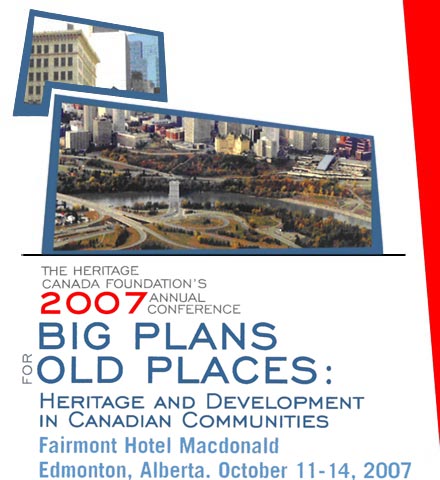
2007: Big Plans Old Places: Heritage and Development in Canadian Communities

An essential event for heritage decision makers, planners, architects and developers, community activists, advocates and consultants.
Conference Program (PDF)
Sponsors
Heritage Canada Works
HCF’s 2007 Conference a Resounding Success
The 220 delegates—who ranged from planners, architects and heritage conservation educators to students, volunteers and advocates—were inspired by keynote speaker Roberta Brandes Gratz, New York’s visionary urban critic and author of The Living City: Thinking Big in a Small Way and Cities Back from the Edge: New Life for Downtown. Ms. Gratz distinguished between “regrowing” urban areas and “rebuilding” them. Regrowing, she argued, is the way to create vital cities with life at street level that offers smaller shops and more intimate cafes while using existing buildings.
Conference sessions kicked off with “Was it Good for You? Marrying Heritage and Development,” moderated by Carleton University’s Heritage Conservation Program director, Herb Stovel. Bringing together a panel of experts in municipal development—a developer, planner, heritage activist and elected official—allowed for a fruitful exploration of the benefits of developing historic places and the barriers working against it.
Later in the conference delegates were treated to an exciting national Blue Ribbon Panel on heritage development, composed of five prominent heritage developers from across Canada, including the moderator, Toronto developer Margaret Zeidler. Frankly, and with humour, they drew from their own experiences to identify many of the missing pieces—creative financing, incentives and more development “intelligence”—required to make building rehabilitation projects the new normal.
The first of the two conference streams, “Managing Change and Development,” focused on urban planning issues. It featured sessions identifying the pressures on Canadian heritage—from insensitive infill to the displacement of rural houses and heritage tourism. Other sessions evaluated the “sticks and carrots” in the heritage conservation toolbox, namely, the merits of heritage planning controls, incentives and protective measures.
A particularly lively panel, moderated by City of Calgary heritage planner David Plouffe, examined the role of civic engagement in protecting heritage resources and how to cultivate involvement. Fascinating case studies were presented including B.C.’s Britannia Beach Mill, the Indian Residential School Museum of Canada in Manitoba, and the NOW House rehab project focusing on post-World War II Victory Housing. They showed how heritage building rehabilitation projects have transformed entire communities and how reusing heritage buildings can support sustainability goals.
The second conference stream, “Revitalizing Communities,” brought to the fore cutting-edge urban renewal strategies in the United States and Canada. It featured Todd Barman from the U.S. National Trust Main Street Center, Bryan Van Sweden from the Pennsylvania Historical and Museum Commission, François Varin from Quebec’s Rues principales Foundation and Larry Pearson from Alberta’s Main Street Program. The stream also included a presentation on how the oldest Main Street project in Alberta, Fort Macleod, was faring after 25 years. On Saturday morning, a mobile workshop took session delegates to Edmonton’s 118th Avenue—an area with social challenges, a burgeoning arts community and tremendous potential—to experience the challenges facing a current Main Street project first hand.face="Times">HCF’s Engaging Stakeholders in Heritage and Development initiative was carried throughout the conference during question periods and the two lunches. The initiative—a national consultation with stakeholders about improving heritage outcomes in property development—kept conference participants busy discussing a variety of related issues. Their significant input will be used in developing HCF’s recommendations concerning priorities to overcome challenges and to more effectively influence decision-making.
A variety of other meetings and events took place, including the 2nd annual meetings of the Built Heritage Leaders Forum and the Heritage Conservation Educators Roundtable. The forum, made up of leaders from province-wide heritage trusts and advocacy organizations, discussed the budget announcement regarding the National Trust. They also participated in working sessions designed to identify and enhance opportunities for collaboration. face="Times">The educators roundtable focused on the issue of ethical standards for heritage conservation practitioners, the need for a concerted research and publication program, and the importance of distance education to promote collaboration and sharing. In each case, a working group was struck to address issues of interest to each of these sectors over the coming months. The conference also offered a total of seven tours, from Edmonton’s Modern built heritage to its Old Strathcona historic district, with the Rossdale Flats and Church Street in between. HCF would like to thank all our sponsors and all the hard-working volunteers who contributed to the shaping of the conference program, who developed and guided the excellent tours, and who assisted with general tasks. We couldn’t have done it without you!
The Heritage Canada Foundation would like to thank the following sponsors and partners for their generous support:

City of Edmonton Planning and Development Department
 Edmonton Historical Board
Edmonton Historical Board
 Alberta Historical Resources Foundation
Alberta Historical Resources Foundation

City of Calgary Land Use Planning & Policy
 Creative City Network |
 Edmonton 2007 Cultural Capital of Canada |
|
Media, Art and Design Edmonton |
 Edmonton Design Committee |

